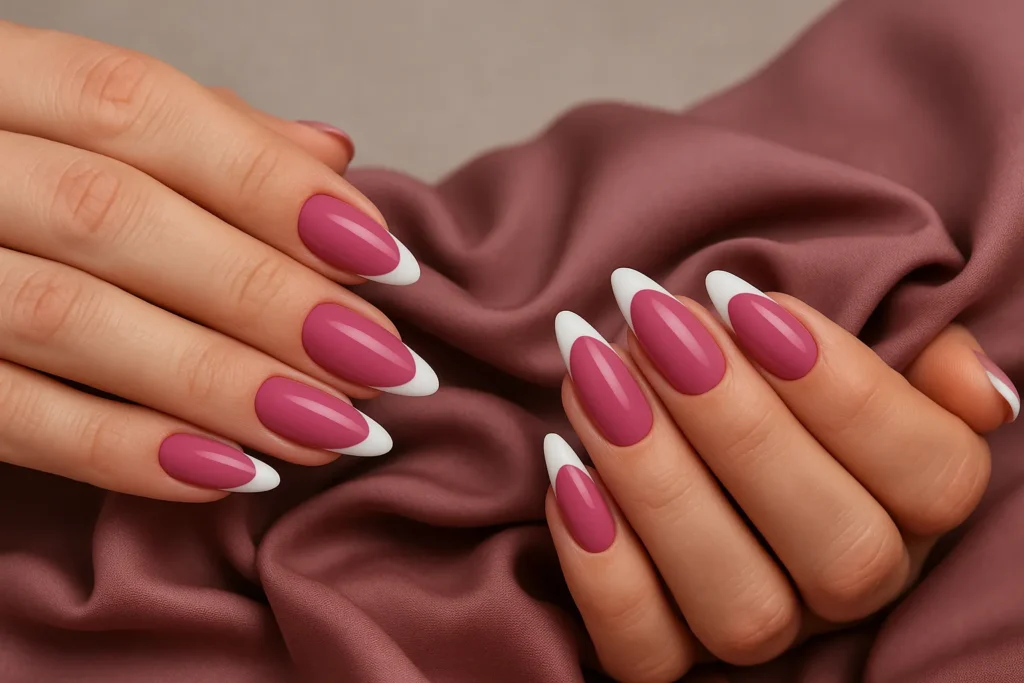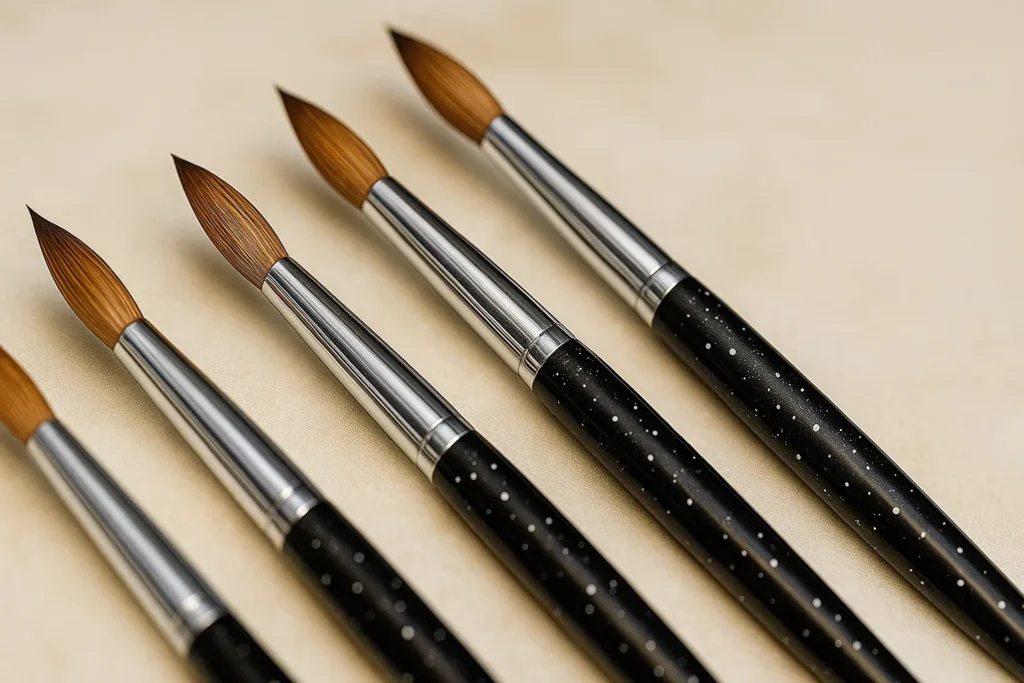Acrylic nails are a fantastic choice for adding strength, length, and a flawless canvas to your fingertips. But if you’re considering them, or already rocking a set, you’re likely asking: How Long Do Acrylic Nails Last? The truth is, it’s not a simple answer. Their longevity isn’t just about the initial application; it’s a partnership between expert technique and your consistent care. Understanding the key factors and committing to a smart aftercare routine is crucial for maximizing their lifespan and keeping your natural nails healthy underneath.
The Lifespan of Your Acrylics
Let’s talk about what to expect from your acrylics, from a fresh set to the essential maintenance that keeps them looking their best.
The Average Lifespan of a Full Set
A brand-new set of acrylic nails typically lasts about 4 to 6 weeks.[1] Some even report up to eight weeks before a full replacement might be considered.[2] However, after roughly eight weeks, it’s generally recommended to remove the existing set and apply a new one.[1] This initial timeframe is just a starting point; the real secret to long-lasting acrylics lies in consistent, proper maintenance, especially with regular fills.
The Importance of Regular Fills
While a full set has its initial run, the true longevity of your acrylics hinges on regular fills. You should be scheduling these appointments every two to three weeks.[2, 1, 3, 4] This isn’t just about keeping your manicure looking neat; it’s absolutely vital for the health of your natural nails. As your natural nails grow, a gap forms between the acrylic and your nail bed.[4] This space can become a breeding ground for moisture and dirt, potentially leading to lifting or even infections.[2, 4]
Ignoring these fills can have serious consequences. That growing gap weakens the entire acrylic structure, making it much easier for the acrylic to snap off, sometimes even damaging your natural nail underneath.[2, 5] The consistent advice from experts about 2-3 week refills highlights that natural nail growth is the primary driver for acrylic maintenance. Fills aren’t just cosmetic; they’re crucial for maintaining nail health and integrity.
Key Factors Influencing How Long Do Acrylic Nails Last
The durability of your acrylics is a result of several elements, from the moment they’re applied to your daily routine. Knowing these factors empowers you to get the most out of your manicure.
The Foundation: Nail Preparation & Application Quality
The quality of the initial application is paramount. It starts with choosing a skilled and experienced nail technician.[2, 1] A good technician understands that proper nail preparation is the absolute bedrock for strong adhesion. This means thoroughly cleaning your natural nail, ensuring it’s free of oils and moisture, and gently buffing the surface.[6] Some may also use a nail dehydrator and an acid-free primer to boost durability and prevent yellowing, creating an optimal bonding surface.[2] If your nails aren’t prepped correctly, the acrylic won’t stick, leading to premature lifting.[6]
Another critical aspect is the correct liquid-to-powder ratio of the acrylic mixture. If it’s too dry, it won’t bond. Too wet, and it spreads too thinly, also causing lifting.[6] Applying acrylic too close to the cuticle or letting it touch the skin can also cause lifting as your natural nail grows. The product needs a small gap to bond directly to the nail without skin contact.[6] Over-filing your natural nail during prep can damage the nail plate, making adhesion difficult and often leading to lifting.[6]
Product Quality Matters
The quality of the acrylic powder and liquid monomer used significantly impacts how long acrylic nails last. High-quality products are formulated for superior adhesion, smoother application, and, ultimately, longer-lasting results.[2, 3, 6] Cheaper or diluted products are more prone to chipping, cracking, and lifting.[2, 6] Investing in reputable brands ensures the materials themselves are designed for optimal performance.
Your Natural Nail Health
The condition of your natural nails beneath the acrylic also plays a role. Healthy, well-maintained natural nails provide a strong, stable base for the acrylic to adhere to, leading to longer-lasting results.[1, 7] Weak or damaged nails, or those not properly prepped, might cause acrylics to lift or break sooner.[7] It’s a common misconception that acrylics inherently damage natural nails. Damage usually comes from improper filing during preparation or rough removal techniques.[1] After removal, nails might feel softer temporarily, but this moisture balance typically restores within 12 hours.[1]
Lifestyle and Daily Habits
Your daily life significantly impacts how long acrylic nails last. Acrylics are tough, but they’re not invincible. Using your nails as tools—for opening cans, scratching, or prying—can cause major damage, leading to chips, cracks, or lifting.[1, 3, 4, 8] As one expert wisely puts it, “Nails are jewels and not tools!”.[4]
Prolonged water exposure can also weaken the bond, making lifting more likely.[7, 8] This is especially true if your job involves frequent hand immersion, like gardening or cleaning.[1] Physical trauma from sports can also compromise them.[7] To protect your nails, wear gloves for chores or activities that could cause damage.[2, 4, 8] Opting for shorter acrylics can also help prevent breakage if you have an active lifestyle.[2]
Environmental Factors
Environmental factors, like humidity and temperature fluctuations, can affect longevity. Extreme changes can weaken the bond, potentially leading to lifting or breakage.[7] Harsh chemicals, such as those in cleaning products with bleach, can make acrylics brittle, causing flaking, peeling, and chipping.[2, 1, 4, 8] Even prolonged contact with chlorine, insect repellent, or sunscreen can affect them.[8] Be mindful of these exposures and take protective measures, like wearing gloves.
Essential Aftercare for Maximizing How Long Do Acrylic Nails Last
Once your acrylics are on, their longevity largely depends on a consistent and diligent aftercare routine. This isn’t just about looks; it’s fundamental to maintaining the integrity of your acrylics and the health of your natural nails.
Daily Hygiene and Moisture
Impeccable hygiene is critical. Dirt and oils can build up under your nails and between the acrylic and natural nail, leading to lifting or even fungal growth.[2, 4] Wash your hands frequently with soap and warm water, and always dry them thoroughly to prevent moisture from compromising the acrylic’s adhesive qualities.[1, 4, 8] A nail brush can help clean underneath, and a wooden stick can remove debris.[2]
Beyond cleanliness, consistent moisturization is vital. Frequent hand washing can dry out your skin and cuticles, potentially leading to cracks and breaks.[2, 4, 8] Regularly apply hand cream and, crucially, cuticle oil to keep your skin and nails hydrated.[2, 4, 7, 8] Healthy, moisturized cuticles and nail beds are essential for maintaining the overall integrity and appearance of your acrylic nails.
Protecting Your Investment: “Nails Are Jewels, Not Tools”
A core principle for extending the life of your acrylics is to treat them with care. As we’ve said, using your nails as tools for prying or scratching can cause significant damage.[4, 8] This simple mindset shift—viewing your nails as delicate “jewels” rather than functional “tools”—can prevent countless chips, cracks, and instances of lifting.
Protecting your nails from physical trauma and harsh chemicals is paramount. Wear rubber gloves when doing household chores, gardening, or cleaning with strong detergents.[2, 4, 8] These activities can weaken the acrylic, causing it to lift or break. This proactive protection is a simple yet highly effective way to safeguard your manicure.
Mindful Product Use
Be mindful of what products come into contact with your acrylic nails. A good rule of thumb: if it can harm your skin, it can harm your nails.[4] Products containing alcohol or substances like bleach will negatively affect your acrylic manicure, making them brittle and prone to damage.[1, 4, 8] While hand sanitizer is convenient, excessive use should be avoided as it can weaken nails; think of it as a Plan B, not a replacement for thorough handwashing.[1] Even certain spices like turmeric can stain nails, so wear gloves when cooking.[8]
Professional Removal is Key
When it’s time to remove your acrylic nails, resist the urge to pick or pry them off at home. This is critically important.[4, 8] Improper removal can cause significant damage to your natural nails underneath, leading to thinning, breakage, and overall weakening.[4, 7, 8] Professional removal minimizes damage and ensures your natural nails remain in the best possible condition, ready for a break or a new set.[4] After removal, it’s a good idea to let your natural nails rest, trimming and moisturizing them to aid recovery before applying another set.[7]
Troubleshooting Common Issues: Why Your Acrylics Might Not Last
Even with the best care, acrylic nails can sometimes encounter issues like lifting or breaking. Understanding the common causes is the first step toward prevention and ensuring a longer-lasting manicure.
Understanding Lifting and Breaking
Lifting occurs when the applied acrylic material separates from the natural nail, usually around the edges or cuticle area.[6, 9] This separation can lead to gaps, air pockets, or even complete detachment.[9] Several factors contribute:
- Poor Nail Preparation: Nails not thoroughly cleaned, dried, and oil-free won’t allow proper adhesion, leading to lifting.[6, 9]
- Incorrect Liquid-to-Powder Ratio: An improper balance can cause lifting. Too dry, it won’t bond; too wet, it spreads too thinly.[6, 9]
- Applying Too Close to the Cuticle: Product touching the cuticle or skin causes lifting as the nail grows.[6, 9]
- Over-Filing the Natural Nail: Excessive filing damages the nail plate, making adhesion difficult.[6, 9]
- Improper Aftercare: Consistent exposure to water, oils, or chemicals weakens the bond.[6, 9] Using nails as tools or long periods in water also contributes.[8, 9]
- Product Thickness: Applying too thickly can trap air and lead to poor adhesion.[9]
- Nail Plate Instability: Nail biting or a thin nail plate can contribute to lifting.[9]
- Incorrect Tip Fit: Wrong size or fit of artificial tips can cause lifting.[9]
Breaking often occurs due to physical trauma, nails being too long or thin for your lifestyle, or a weakened structure from neglected fills.[2]
Preventing Common Problems
Preventing these issues involves diligent application and consistent aftercare:
- Proper Nail Preparation: Always start with meticulously clean, dry nails. Push back cuticles, gently buff, and use a dehydrator.[6, 9]
- Master the Liquid-to-Powder Ratio: Practice to achieve the correct consistency for the acrylic bead—soft but not runny.[6]
- Avoid Flooding the Cuticles: Leave a small, precise gap between the product and the cuticle area. This allows proper bonding and accommodates growth, preventing lifting.[6]
- Use High-Quality Products: Quality acrylic powder and liquid monomer significantly impact adhesion, smoothness, and durability, reducing lifting.[6]
- Educate Yourself on Aftercare: Avoid prolonged water exposure, wear gloves for chores, and steer clear of lotions and oils around the cuticle area, as these can weaken the bond.[6] Remember, nails are not tools.[4]
- Regular Maintenance: Consistent refills every 2-3 weeks prevent the growth gap from becoming problematic, reducing lifting and breakage.[4, 5]
By proactively addressing these factors, you can significantly extend the life of your acrylic nails and enjoy a flawless manicure for longer.
Conclusion
The question of How Long Do Acrylic Nails Last truly depends on a partnership: expert application from your technician and your diligent at-home care. While a fresh set provides a beautiful foundation for 4-8 weeks, it’s your commitment to regular refills every two to three weeks that truly dictates their sustained longevity and the health of your natural nails. Factors like your technician’s skill, product quality, and your natural nail health all play pivotal roles in the initial success of your manicure.
But here’s the empowering part: the power to extend your acrylics’ lifespan largely rests in your hands. By adopting essential aftercare practices—maintaining rigorous hygiene, moisturizing regularly, protecting your nails from trauma and harsh chemicals, and always opting for professional removal—you can significantly enhance their durability and appearance. Understanding the common causes of lifting and breakage empowers you to prevent these issues, ensuring your acrylics remain strong and beautiful.
Your acrylic nails are an investment in your personal style and self-care. By treating them as the “jewels” they are, and by consistently applying these expert tips, you’re not just maintaining a manicure; you’re nurturing the health of your natural nails and confidently showcasing your polished look. Embrace these practices, and enjoy the lasting beauty of your acrylics!




